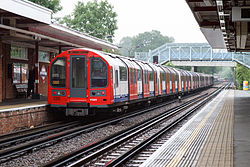
Rapid transit
High-capacity public transport commonly found in urban areas / From Wikipedia, the free encyclopedia
Dear Wikiwand AI, let's keep it short by simply answering these key questions:
Can you list the top facts and stats about Rapid transit?
Summarize this article for a 10 years old
Rapid transit or mass rapid transit (MRT), also known as heavy rail or metro, is a type of high-capacity public transport that is generally built in urban areas. A rapid transit system that primarily or traditionally runs below the surface may be called a subway, tube, or underground.[1][2][3][4] Unlike buses or trams, rapid transit systems are railways, usually electric, that operate on an exclusive right-of-way, which cannot be accessed by pedestrians or other vehicles.[5] They are often grade-separated in tunnels or on elevated railways.




Modern services on rapid transit systems are provided on designated lines between stations typically using electric multiple units on railway tracks. Some systems use guided rubber tires, magnetic levitation (maglev), or monorail. The stations typically have high platforms, without steps inside the trains, requiring custom-made trains in order to minimize gaps between train and platform. They are typically integrated with other public transport and often operated by the same public transport authorities. Some rapid transit systems have at-grade intersections between a rapid transit line and a road or between two rapid transit lines.[6]
The world's first rapid transit system was the partially underground Metropolitan Railway which opened in 1863 using steam locomotives, and now forms part of the London Underground.[7] In 1868, New York opened the elevated West Side and Yonkers Patent Railway, initially a cable-hauled line using static steam engines.
As of 2021[update], China has the largest number of rapid transit systems in the world—40 in number,[8] running on over 4,500 km (2,800 mi) of track—and was responsible for most of the world's rapid-transit expansion in the 2010s.[9][10][11] The world's longest single-operator rapid transit system by route length is the Shanghai Metro.[12][13] The world's largest single rapid transit service provider by number of stations (472 stations in total)[14] is the New York City Subway. The three busiest rapid transit systems in the world by annual ridership are the Shanghai Metro, Tokyo subway system and the Moscow Metro.